Tom Murphy doesn’t mince his words when it comes to the importance of driving lessons for teenagers.
“Irish people think driving lessons are a rip-off. Your children, if they don’t get good training at 17, they won’t last long on the road, because the roads are five times busier than what they were in 1985,” says Tom, a member of the invite-only Institute of Masters of Driving Tuition (basically Mensa for driving instructors.)
Irish Country Living travelled to Cork to meet with Tom, one of the founders of the Airport Driving School, and Alan Early, its current managing director. The school has been operating in Dublin since 1968 but recently opened a new base in the southern city.
Driving lessons are a pretty solid birthday or Christmas present, but lessons are lessons, right? Not so, according to Tom, himself, a highly decorated instructor involved on a daily basis in training. “We don’t train you to pass a test, we train you to drive. I don’t know what price people put on their lives. Parents won’t spend €600 on a course of [driving] lessons but will spend thousands on horse lessons, music, dancing and swimming. But wait till you get a car, the most dangerous thing they have ever done and then ‘any eejit can drive!’[Kids] go experiment and drive into a bloody wall,” he argues.
He poses a question: “Would you want a good instructor or a tipster down the road?” He suggests the latter will simply get you through the test because “you went around the route 50 times but really, you can’t drive”.
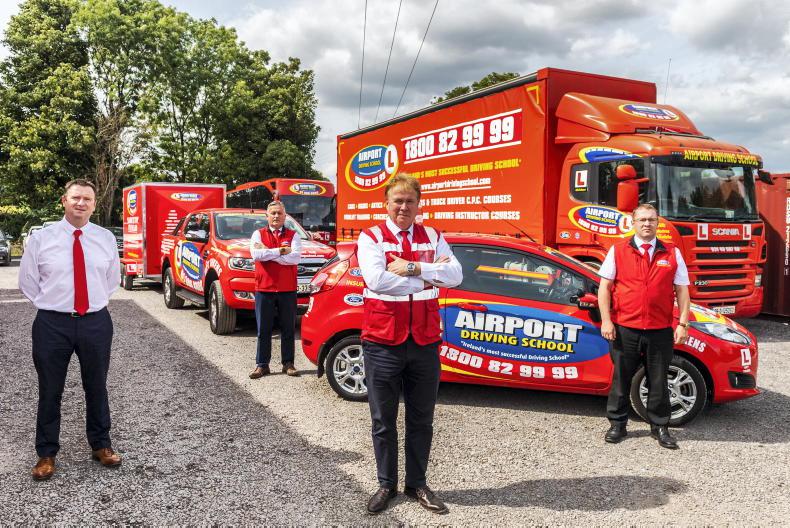
Airport Driving School employee Pat O'Donovan; managing director Alan Early; CEO Tom Murphy and employee Andrejs Nosovs with a selection of the company's learner vehicles. \ Andy Gibson.
Alan expands on this training system. “We would bring someone to a multi-storey carpark. Why? Because, you know yourself, shopping at a big busy shopping centre and you drive up the first ramp, get to the top and someone’s stopped, and you’re stopped, panic stations set in. So we simulate that. Another one, you cannot drive on a motorway as a learner. So, we bring them to the airport where you have a couple of hundred yards to get across three lanes – real-life simulation. Similar to the trucks – we bring them into the loading bay, reversing areas and tight spots.”
Essential driver training
Back in the day, parents taught their kids to drive. You got your tractor licence at 16 and the provisional at 17 had you on the road.
But in 2011, a Government regulation introduced minimum requirements in the form of 12 hours (of lessons) “essential driver training” (EDT).
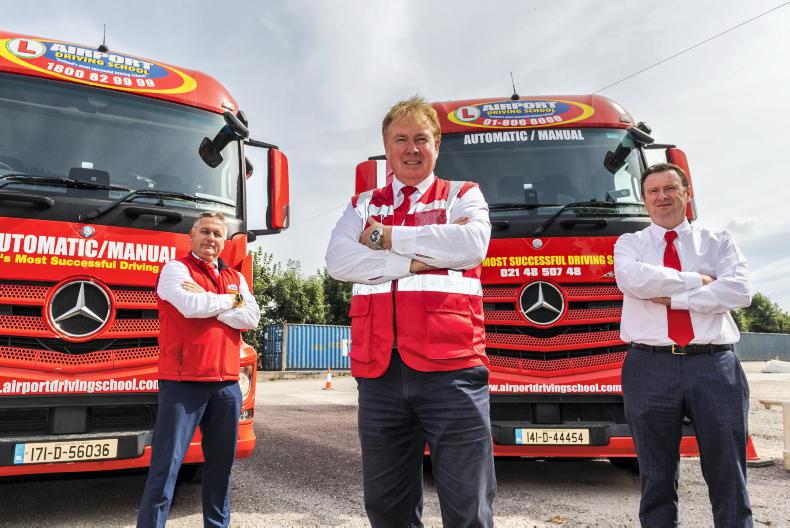
Airport Driving School Managing Director Alan Early; CEO Tom Murphy and employee Pat O'Donovan. \ Andy Gibson.
Alan notes that Ireland actually lags behind on this, as it’s only for cars, and in other countries the hours required are greater. He does acknowledge, however, that “the accident rate of people who do the EDT has come down, with a lot more passing the test first time”.
Warehouse to wheels
Driving can be a rewarding job and is a skillset very much in demand. With one of the newest training fleets in Europe, the school has 64 instructors. Of these, 42 are car instructors with the rest motorbike and heavy goods vehicles (HGVs) instructors. Five years ago the school developed a programme called Warehouse to Wheels. This is for companies that recognised someone in their business, perhaps working in the warehouse, that doesn’t have a licence.
“It’s very hard to get drivers, so why not use them?” Alan explains. “Invest the money that you pay an agency driver in your own staff and get them the licence. They’re probably going to stick with you a lot longer.”
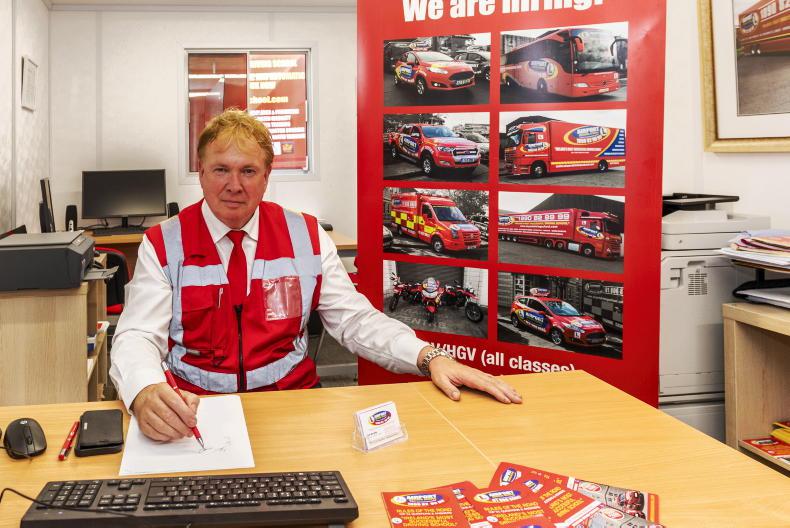
Airport Driving School CEO Tom Murphy. \ Andy Gibson.
Another initiative is their transition year programme run at Navan racecourse. This four-hour driving programme sees pupils [with an instructor] drive around a set route and do the [mock] theory test as a quiz afterwards. Because it’s off-road, they can do it without having their learner permit.
Trailer licence
Many people are driving their cattle to the mart or ponies to the gymkhana without that +E on their license. Alan advises that the very first thing that is necessary is an assessment.
“A lot of people ring up asking for a cost, but that is very much ‘how long is a piece of string?’ You might be a brilliant driver or you might be the worst driver and it depends. It’s €100 for the assessment and then we can tell you how much it is going to cost because we will know how many hours are needed.”
Companies use the assessment service to get a better idea of the capability of their staff. Recommendations are fed back but it’s entirely up to the employer what they do with that recommendation. This recommendation, Alan says, could be “you need two hours to work on approaching roundabouts, or your separation distance between cars is not good enough. We all just fall into [bad] habits driving.”
Environmental impact
Fuel is the biggest cost that a transport operator would have and the school is seeing more people being sent to learn how to drive more economically.
“A lot of these trucks have lower-range gearboxes. They don’t rev as much, and they use less fuel, depending on how they are driven. All of the vehicles can be driven in eco mode. It restricts everything, it doesn’t allow over-revving and it keeps your speed limit down. From a safe driving point of view, we’d be teaching people to brake slowly, and slow off in acceleration. A vehicle of 18 or 20 tonnes can’t be driven like a go-kart. It needs to move off slowly, use gentle acceleration and gentle braking so it’s not putting on as much pressure, not using as much diesel.”
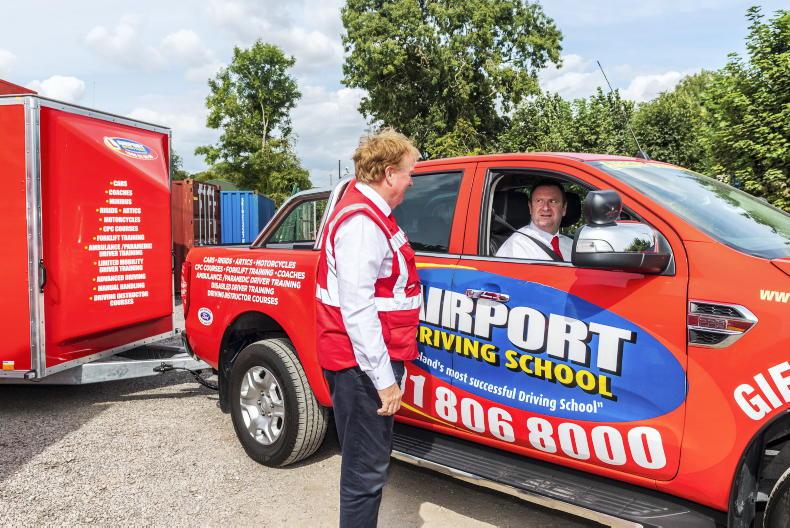
Airport Driving School CEO Tom Murphy gives a towing lesson to employee Pat O'Donovan. \ Andy Gibson.
Alan sees a transition happening with bus companies buying hydrogen buses, but this, he says, is no panacea to our fuel worries. “They are sitting in the depot because there’s nowhere to fill them with hydrogen in Ireland. Electricity isn’t the answer for commercial vehicles at the moment as there’s too much weight involved. Range anxiety is a big thing. You could drive for a couple of days on a fill of diesel but taking an electric truck across the continent, it takes forever. Any change will be a long time after I’m gone,” he says. This reliance on road movement is not just for freight, it’s people too. When I suggest to Alan that this is particularly so in rural Ireland, where public transport is almost non-existent, the Dublin native argues against my generalisation.
“Try to get from Skerries to a commercial centre like Blanchardstown. It’s a bus into Dublin and another out to Blanch, two-and-a-half hours for a 35-minute journey in a car,” he counters.
Tractor
licence
With tractors, there are no lessons because there is no specific test. I ask Alan why there is no requirements vis-à-vis tractors and he explains that to sit a tractor test, the tractor has to be a manual tractor and it has to have a jump seat for the instructor.
“Now with the best will in the world, the last manual tractor I think came off the line in 1995. So you’re looking at a tractor that’s nearly 30 years old at this stage. Also the RSA have to apply to the Government to change the licensing laws and it’s got held up a couple of times with the farm organisations [arguing against it].
“A tractor could be towing as much as an articulated lorry. You have a car licence, you’re covered on a tractor, but driving a tractor that’s nearly 40ft long, it’d be better to have a licence.”
Read more
Cause it's another day for you and me in paradise
O’ the Hills of Donegal - stories and song on the northwest’s camino
Tom Murphy doesn’t mince his words when it comes to the importance of driving lessons for teenagers.
“Irish people think driving lessons are a rip-off. Your children, if they don’t get good training at 17, they won’t last long on the road, because the roads are five times busier than what they were in 1985,” says Tom, a member of the invite-only Institute of Masters of Driving Tuition (basically Mensa for driving instructors.)
Irish Country Living travelled to Cork to meet with Tom, one of the founders of the Airport Driving School, and Alan Early, its current managing director. The school has been operating in Dublin since 1968 but recently opened a new base in the southern city.
Driving lessons are a pretty solid birthday or Christmas present, but lessons are lessons, right? Not so, according to Tom, himself, a highly decorated instructor involved on a daily basis in training. “We don’t train you to pass a test, we train you to drive. I don’t know what price people put on their lives. Parents won’t spend €600 on a course of [driving] lessons but will spend thousands on horse lessons, music, dancing and swimming. But wait till you get a car, the most dangerous thing they have ever done and then ‘any eejit can drive!’[Kids] go experiment and drive into a bloody wall,” he argues.
He poses a question: “Would you want a good instructor or a tipster down the road?” He suggests the latter will simply get you through the test because “you went around the route 50 times but really, you can’t drive”.

Airport Driving School employee Pat O'Donovan; managing director Alan Early; CEO Tom Murphy and employee Andrejs Nosovs with a selection of the company's learner vehicles. \ Andy Gibson.
Alan expands on this training system. “We would bring someone to a multi-storey carpark. Why? Because, you know yourself, shopping at a big busy shopping centre and you drive up the first ramp, get to the top and someone’s stopped, and you’re stopped, panic stations set in. So we simulate that. Another one, you cannot drive on a motorway as a learner. So, we bring them to the airport where you have a couple of hundred yards to get across three lanes – real-life simulation. Similar to the trucks – we bring them into the loading bay, reversing areas and tight spots.”
Essential driver training
Back in the day, parents taught their kids to drive. You got your tractor licence at 16 and the provisional at 17 had you on the road.
But in 2011, a Government regulation introduced minimum requirements in the form of 12 hours (of lessons) “essential driver training” (EDT).

Airport Driving School Managing Director Alan Early; CEO Tom Murphy and employee Pat O'Donovan. \ Andy Gibson.
Alan notes that Ireland actually lags behind on this, as it’s only for cars, and in other countries the hours required are greater. He does acknowledge, however, that “the accident rate of people who do the EDT has come down, with a lot more passing the test first time”.
Warehouse to wheels
Driving can be a rewarding job and is a skillset very much in demand. With one of the newest training fleets in Europe, the school has 64 instructors. Of these, 42 are car instructors with the rest motorbike and heavy goods vehicles (HGVs) instructors. Five years ago the school developed a programme called Warehouse to Wheels. This is for companies that recognised someone in their business, perhaps working in the warehouse, that doesn’t have a licence.
“It’s very hard to get drivers, so why not use them?” Alan explains. “Invest the money that you pay an agency driver in your own staff and get them the licence. They’re probably going to stick with you a lot longer.”

Airport Driving School CEO Tom Murphy. \ Andy Gibson.
Another initiative is their transition year programme run at Navan racecourse. This four-hour driving programme sees pupils [with an instructor] drive around a set route and do the [mock] theory test as a quiz afterwards. Because it’s off-road, they can do it without having their learner permit.
Trailer licence
Many people are driving their cattle to the mart or ponies to the gymkhana without that +E on their license. Alan advises that the very first thing that is necessary is an assessment.
“A lot of people ring up asking for a cost, but that is very much ‘how long is a piece of string?’ You might be a brilliant driver or you might be the worst driver and it depends. It’s €100 for the assessment and then we can tell you how much it is going to cost because we will know how many hours are needed.”
Companies use the assessment service to get a better idea of the capability of their staff. Recommendations are fed back but it’s entirely up to the employer what they do with that recommendation. This recommendation, Alan says, could be “you need two hours to work on approaching roundabouts, or your separation distance between cars is not good enough. We all just fall into [bad] habits driving.”
Environmental impact
Fuel is the biggest cost that a transport operator would have and the school is seeing more people being sent to learn how to drive more economically.
“A lot of these trucks have lower-range gearboxes. They don’t rev as much, and they use less fuel, depending on how they are driven. All of the vehicles can be driven in eco mode. It restricts everything, it doesn’t allow over-revving and it keeps your speed limit down. From a safe driving point of view, we’d be teaching people to brake slowly, and slow off in acceleration. A vehicle of 18 or 20 tonnes can’t be driven like a go-kart. It needs to move off slowly, use gentle acceleration and gentle braking so it’s not putting on as much pressure, not using as much diesel.”

Airport Driving School CEO Tom Murphy gives a towing lesson to employee Pat O'Donovan. \ Andy Gibson.
Alan sees a transition happening with bus companies buying hydrogen buses, but this, he says, is no panacea to our fuel worries. “They are sitting in the depot because there’s nowhere to fill them with hydrogen in Ireland. Electricity isn’t the answer for commercial vehicles at the moment as there’s too much weight involved. Range anxiety is a big thing. You could drive for a couple of days on a fill of diesel but taking an electric truck across the continent, it takes forever. Any change will be a long time after I’m gone,” he says. This reliance on road movement is not just for freight, it’s people too. When I suggest to Alan that this is particularly so in rural Ireland, where public transport is almost non-existent, the Dublin native argues against my generalisation.
“Try to get from Skerries to a commercial centre like Blanchardstown. It’s a bus into Dublin and another out to Blanch, two-and-a-half hours for a 35-minute journey in a car,” he counters.
Tractor
licence
With tractors, there are no lessons because there is no specific test. I ask Alan why there is no requirements vis-à-vis tractors and he explains that to sit a tractor test, the tractor has to be a manual tractor and it has to have a jump seat for the instructor.
“Now with the best will in the world, the last manual tractor I think came off the line in 1995. So you’re looking at a tractor that’s nearly 30 years old at this stage. Also the RSA have to apply to the Government to change the licensing laws and it’s got held up a couple of times with the farm organisations [arguing against it].
“A tractor could be towing as much as an articulated lorry. You have a car licence, you’re covered on a tractor, but driving a tractor that’s nearly 40ft long, it’d be better to have a licence.”
Read more
Cause it's another day for you and me in paradise
O’ the Hills of Donegal - stories and song on the northwest’s camino









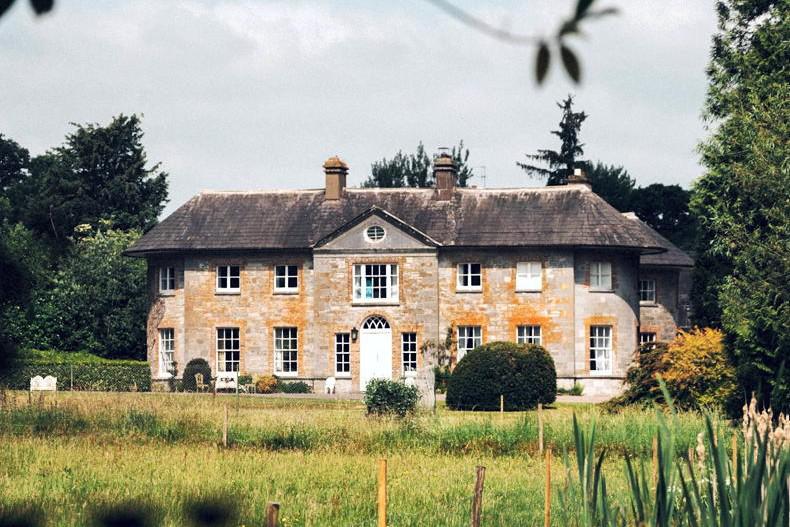

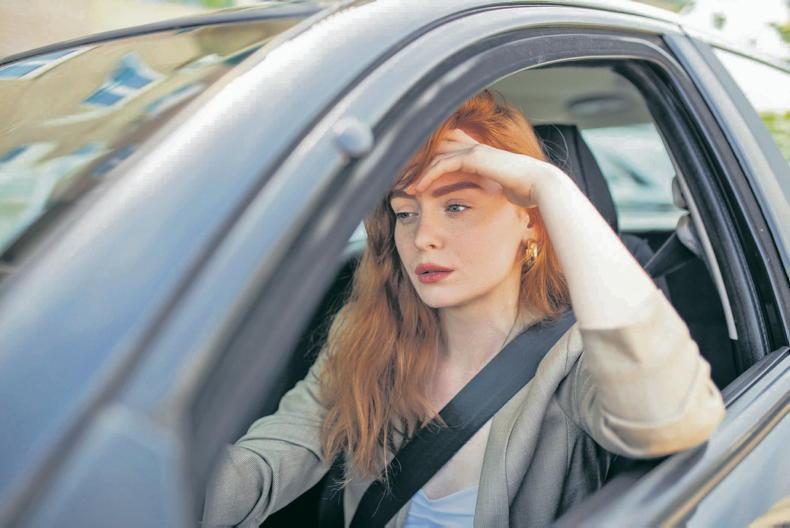

SHARING OPTIONS